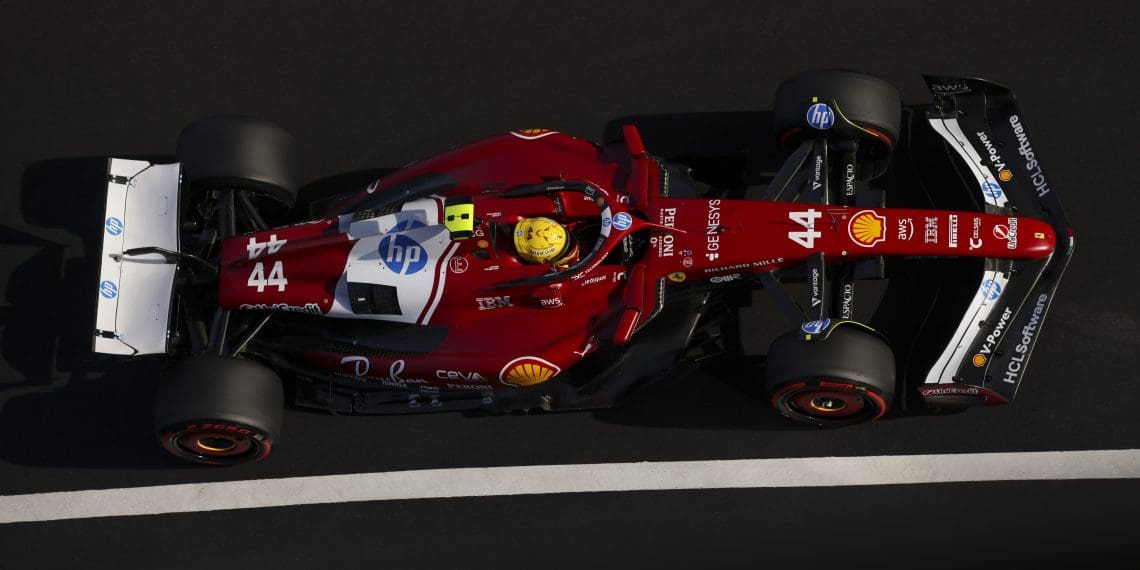In the fallout of the Chinese Grand Prix, rumblings from the paddock hint that a potential alteration in Ferrari’s SF-25 set-up may have been the catalyst for both Lewis Hamilton and Charles Leclerc’s disqualifications. The speculation was ignited by Sky F1 analyst Bernie Collins, a former insider at McLaren and Aston Martin, who delved into the factors that possibly led to Ferrari’s disappointing outing.
Hamilton, in his second race weekend with Ferrari, kicked off with a promising start by snatching the Sprint pole and then commanding the mini-race to triumph. However, following his confirmation that set-up changes were introduced for the SF-25 during qualifying and the main race, Ferrari’s momentum seemed to evaporate. The end result saw Leclerc and Hamilton finish at P5 and P6 respectively, but their woes deepened post-race when Leclerc was disqualified for an underweight vehicle, and Hamilton was ousted for excessive plank wear.
Collins, with her rich experience as McLaren’s senior performance engineer and Aston Martin’s strategy chief, was queried about whether the adjustments to the Ferrari SF-25 could have contributed to Hamilton’s downfall. She noted that it wasn’t unusual to tweak set-ups post-Sprint, particularly as cars typically don’t run at full fuel capacity during these races. This could include increasing the ride height in anticipation of a higher fuel start.
Drawing a comparison to the Austin Grand Prix two years prior, where Hamilton, then with Mercedes, was disqualified for similar reasons, Collins pointed out that set-up modifications between the Sprint and main race were not permitted then. Therefore, any plank wear identified in the Sprint couldn’t be addressed. However, she suggested the management in the Sprint race was more intensive, involving more laps on a hard tyre, while a medium tyre was used for management in the Sprint, potentially leading to increased wear and fuel consumption in the main event.
Collins also commented that while it is standard for all teams to elevate their cars in Australia due to the bumpy terrain, Ferrari’s performance there was lackluster. She speculated that the car’s performance could be overly sensitive to ride height changes in terms of aerodynamics, which could be problematic, given that flexibility in ride height adjustments is crucial for different track conditions.
The Chinese Grand Prix saw the majority of the grid opting for a one-stop strategy, transitioning from Pirelli mediums to hards. Hamilton, on the other hand, chose a two-stop strategy, going medium-hard-hard. Collins suggested that this decision could have influenced the plank wear on Hamilton’s Ferrari. However, she also considered the possibility that damage from the Leclerc incident might have played a role.
In Leclerc’s case, Ferrari acknowledged that they misjudged the amount of tyre wear on the hard tyres, leading to his disqualification for an underweight car. Collins revealed that the paddock was somewhat in the dark regarding the hard tyre’s wear rate. While teams are permitted to collect pick-up and change front wings, the exact source of the loss in mass for Leclerc’s car remains a mystery.
This entire saga underscores the intricate dance between strategy and execution in Formula 1, where even minor adjustments can have significant ramifications. As Ferrari grapples with the aftermath of the Chinese Grand Prix, the focus now shifts to how they can mitigate these issues moving forward.













